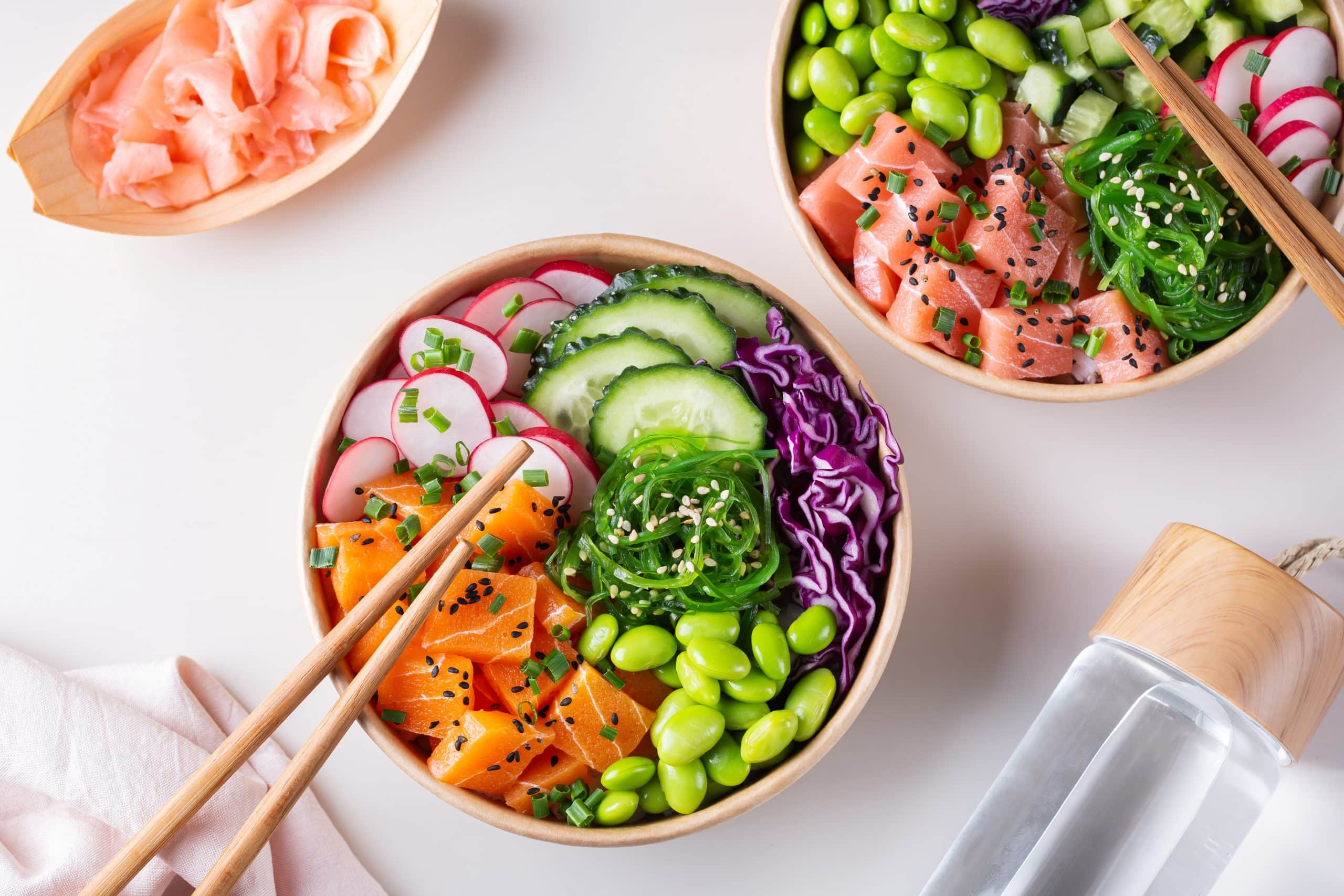The rise in popularity of plant-based diets has led to innovative culinary creations that replicate the taste, texture, and nutritional profile of traditional animal-based dishes. One such creation is the plant-based tuna poke bowl, which offers a delicious and sustainable alternative to the classic Hawaiian dish. This article explores the ingredients, preparation methods, nutritional benefits, and environmental impact of plant-based tuna poke bowls, making it easier for you to enjoy this delightful meal.
Poke (pronounced poh-kay) is a traditional Hawaiian dish that typically features diced raw fish, such as tuna or salmon, marinated in a mixture of soy sauce, sesame oil, and other seasonings. It is often served over a bed of rice and topped with various vegetables, seaweed, and other garnishes. Poke bowls have gained widespread popularity due to their fresh flavors, customizable nature, and perceived health benefits.
However, concerns about overfishing, mercury content, and the environmental impact of seafood have driven many to seek plant-based alternatives. Enter the plant-based tuna poke bowl, a dish that captures the essence of traditional poke while being kinder to the planet and more inclusive of dietary preferences.
Ingredients of Plant-Based Tuna Poke Bowl
Creating a plant-based tuna poke bowl involves using ingredients that mimic the texture and flavor of tuna while providing a nutritious and satisfying meal. Here’s a breakdown of the key components:
1. Plant-Based Tuna Alternatives
There are several commercially available plant-based tuna products on the market. These are typically made from ingredients such as soy protein, pea protein, algae, and other plant-based components. They are designed to replicate the texture and taste of real tuna, making them an excellent substitute in poke bowls.
Alternatively, you can use marinated watermelon or tomato as a homemade plant-based tuna substitute. When properly marinated, these fruits take on a similar texture and flavor profile to raw tuna.
2. Marinade
The marinade is crucial for infusing the plant-based tuna with the rich, savory flavors characteristic of poke. A typical marinade might include:
- Soy sauce or tamari (for a gluten-free option)
- Sesame oil
- Rice vinegar
- Lime juice
- Ginger
- Garlic
- Scallions
- Red pepper flakes or sriracha for heat
- A touch of sweetener like maple syrup or agave nectar
3. Base
The base of a poke bowl is traditionally white rice, but you can also use brown rice, quinoa, cauliflower rice, or mixed greens for a lower-carb option.
4. Toppings
A variety of fresh and vibrant toppings not only add nutritional value but also enhance the visual appeal and flavor of the bowl. Popular toppings include:
- Avocado
- Cucumber
- Edamame
- Seaweed salad
- Shredded carrots
- Radishes
- Mango or pineapple for a sweet touch
- Pickled ginger
- Sesame seeds
5. Sauces and Garnishes
Finishing touches such as spicy mayo, ponzu sauce, and furikake (a Japanese seasoning mix) can elevate the flavors of your plant-based poke bowl.
Preparation Method
Making a plant-based tuna poke bowl is straightforward and can be done in a few simple steps:
- Prepare the Plant-Based Tuna: If using a commercial product, follow the package instructions. For homemade alternatives, dice watermelon or tomatoes into bite-sized cubes. Marinate them in a mixture of soy sauce, sesame oil, rice vinegar, lime juice, ginger, and garlic for at least 30 minutes to allow the flavors to meld.
- Cook the Base: Prepare your choice of rice or grains according to package instructions. If using greens, wash and dry them thoroughly.
- Assemble the Bowl: Start with a generous serving of your base. Arrange the marinated plant-based tuna on top, then add your desired toppings in an aesthetically pleasing manner.
- Add Sauces and Garnishes: Drizzle with your favorite sauces and sprinkle garnishes over the top to finish.
- Serve and Enjoy: Mix everything together to distribute the flavors evenly and enjoy your delicious, plant-based poke bowl.
Nutritional Benefits
Plant-based tuna poke bowls are not only delicious but also packed with nutritional benefits:
1. Rich in Protein
Plant-based tuna alternatives made from soy or pea protein provide a substantial amount of protein, making them a great option for those looking to meet their protein needs without consuming animal products.
2. High in Fiber
Using a base of brown rice, quinoa, or mixed greens, along with a variety of vegetables, ensures that the bowl is high in dietary fiber, which aids in digestion and promotes a feeling of fullness.
3. Healthy Fats
Ingredients like avocado, sesame oil, and edamame contribute heart-healthy fats to the dish, supporting overall cardiovascular health.
4. Vitamins and Minerals
The assortment of vegetables and fruits in a poke bowl provides a wide range of vitamins and minerals, including vitamins A, C, E, and K, as well as potassium, magnesium, and antioxidants.
5. Low in Mercury
One of the significant advantages of plant-based tuna is the absence of mercury, a concern with traditional tuna consumption. This makes it a safer option for everyone, including pregnant women and young children.
Subscribe to our youtube channel Kitchenpedia for more delicious recipes and hit the like button if you enjoyed this video. Share it with your friends and Family.
Environmental Impact
Switching to plant-based alternatives has a positive impact on the environment. Here’s how plant-based tuna poke bowls contribute to sustainability:
1. Reduced Overfishing
Overfishing is a critical issue that depletes ocean ecosystems and threatens marine biodiversity. By opting for plant-based alternatives, we reduce the demand for wild-caught fish and help preserve aquatic life.
2. Lower Carbon Footprint
Producing plant-based proteins generally requires fewer resources and generates lower greenhouse gas emissions compared to animal-based proteins. This means a smaller carbon footprint for plant-based tuna.
3. Conservation of Marine Life
Choosing plant-based options helps protect endangered species and supports marine conservation efforts, contributing to healthier oceans.
4. Sustainable Ingredients
Many plant-based tuna products are made from sustainably sourced ingredients, further enhancing their environmental benefits.
Customization and Variations
One of the joys of poke bowls is their versatility. Here are some ideas for customizing your plant-based tuna poke bowl:
1. Spicy Plant-Based Tuna Poke Bowl
Add extra sriracha or chili flakes to the marinade and top with spicy mayo for a kick of heat.
2. Tropical Plant-Based Tuna Poke Bowl
Incorporate tropical fruits like mango or pineapple for a sweet contrast to the savory elements.
3. Crunchy Plant-Based Tuna Poke Bowl
Add crunchy toppings such as crushed nuts, crispy fried onions, or wonton strips for added texture.
4. Superfood Plant-Based Tuna Poke Bowl
Boost the nutritional content by including superfoods like kale, chia seeds, and avocado.
5. Low-Carb Plant-Based Tuna Poke Bowl
Swap out the rice for cauliflower rice or a bed of greens to reduce the carbohydrate content.
Get more Recipes – Click Here
The plant-based tuna poke bowl is a delicious, nutritious, and environmentally friendly alternative to traditional poke. With a variety of plant-based tuna options and an array of fresh, flavorful ingredients, you can enjoy this classic Hawaiian dish while aligning with your dietary preferences and sustainability goals.
By following the steps outlined in this article, you can create a plant-based tuna poke bowl that is not only satisfying and delicious but also kind to the planet. Whether you’re a seasoned vegan, a curious omnivore, or someone looking to reduce their seafood consumption, the plant-based tuna poke bowl is a fantastic addition to your culinary repertoire. Enjoy experimenting with different ingredients and flavors to make this dish your own, and take pride in the positive impact your food choices have on your health and the environment.

